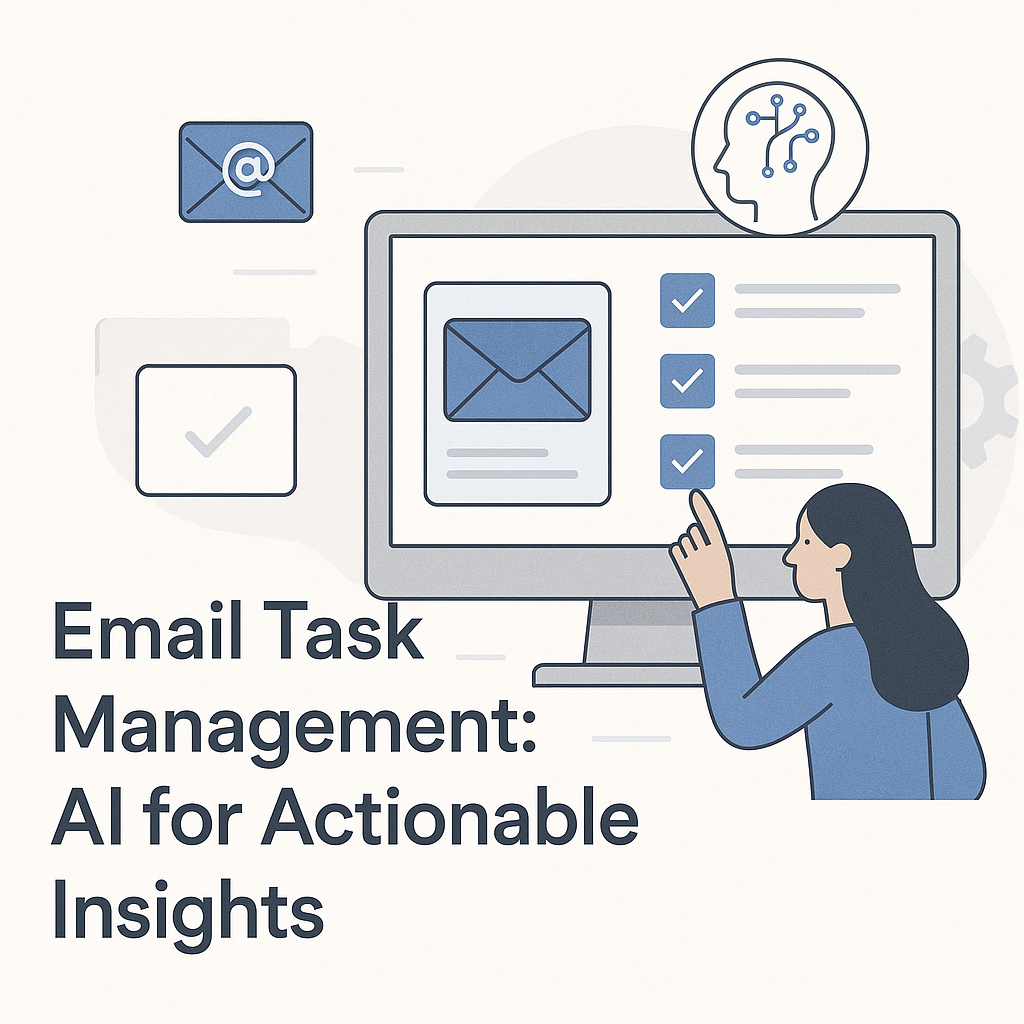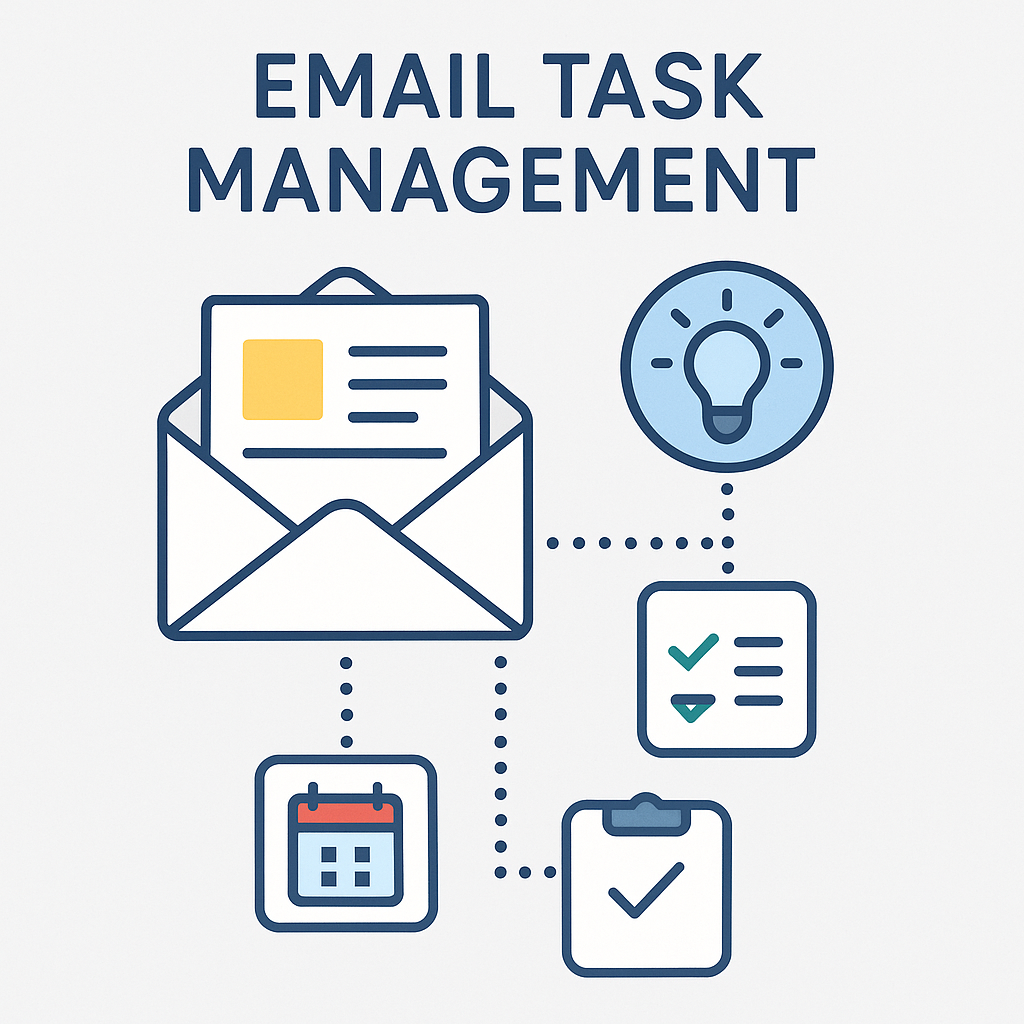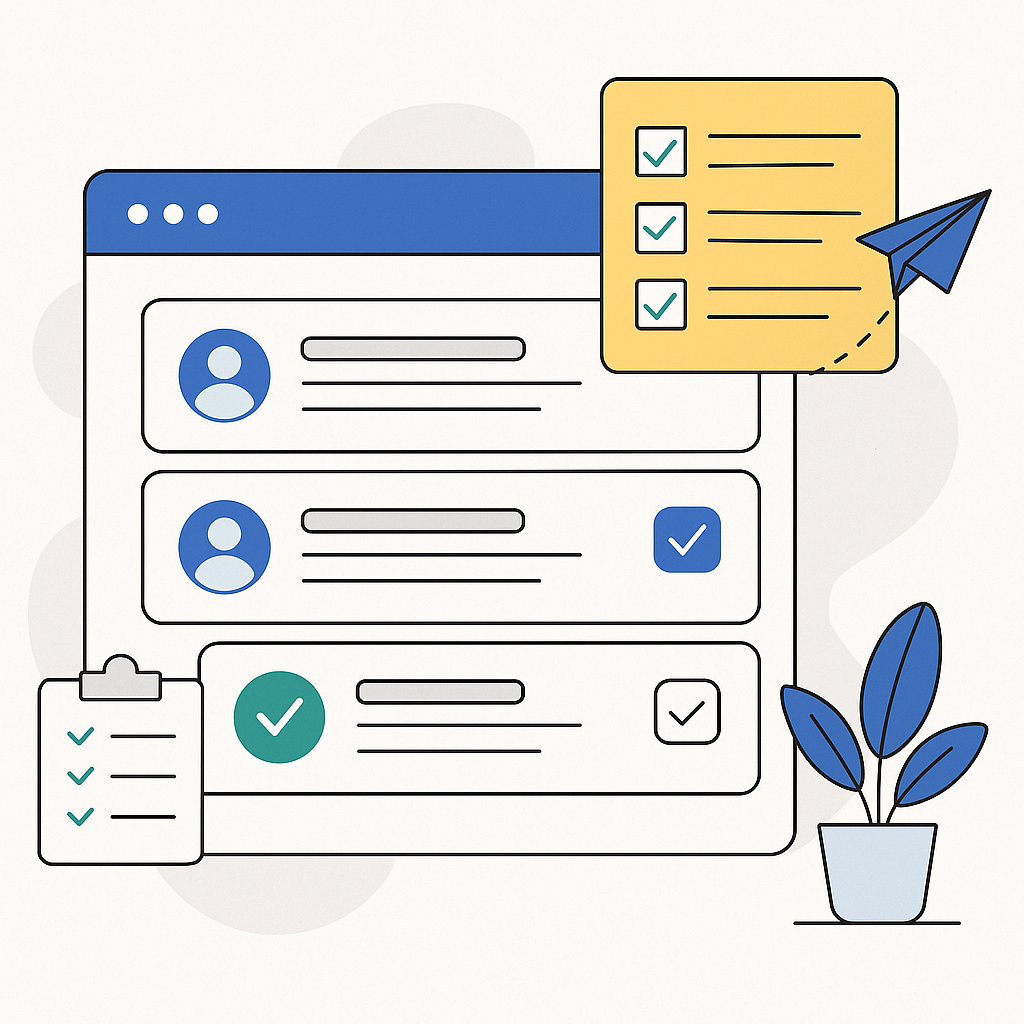Email Task Management: AI for Actionable Insights

In today's hyper-connected world, the inbox has become the de facto command center for many professionals. From crucial client requests and project updates to team coordination and urgent follow-ups, our emails are a constant stream of information. But what happens when that stream becomes a flood? For many, the inbox is less of a productivity hub and more of a source of stress and missed opportunities. This is where effective email task management becomes not just helpful, but essential. The challenge lies in transforming raw, unstructured email content into clear, actionable to-dos. Busy professionals, entrepreneurs, and entire sales and marketing teams often find themselves drowning in emails, struggling to identify priorities, delegate effectively, and ensure nothing falls through the cracks. This is precisely the problem that Artificial Intelligence (AI) is poised to solve, revolutionizing how we approach our daily communication and tasks.
Why Traditional Email Task Management Falls Short
For years, we've relied on a patchwork of methods to manage tasks buried within our emails. We've flagged messages, starred important ones, created separate to-do lists in spreadsheets or notebooks, or painstakingly copied and pasted action items into dedicated task management software. While these methods might have sufficed in a less demanding era, they are fundamentally inefficient and prone to error in the face of modern communication volumes.
The act of manually sifting through hundreds of emails daily to find tasks is incredibly time-consuming. It disrupts focus, increases cognitive load, and often leads to tasks being forgotten or delayed. Consider the common scenario: you receive an email requesting a specific action by a deadline. You flag it. Later, you receive another critical request. You flag that too. Soon, your inbox is a sea of flags, each representing a potential task, but without a clear system for prioritization or tracking progress. This manual approach directly conflicts with the principles of an inbox zero strategy, which aims for an empty inbox by processing emails efficiently, rather than letting them accumulate.
Furthermore, these traditional email organization tips often lack integration. A flagged email might represent a task that needs to be added to a project management board, a calendar event, or a CRM entry. Manually bridging these gaps creates more work and increases the likelihood of data inconsistencies. The result? Lost productivity, missed deadlines, and the persistent feeling of being overwhelmed by your own communications. It’s a system designed for a bygone era, ill-equipped to handle the demands of today's fast-paced professional landscape. For a deeper dive into how insights from your email can drive decisions, explore Email Insights: Drive Decisions with Your Inbox Data.
AI's Role: Turning Emails into Actionable Tasks
This is where Artificial Intelligence steps in, offering a transformative approach to email task management. AI, particularly through Natural Language Processing (NLP) and machine learning, can understand the context, intent, and specific details within an email message far more effectively than manual scanning. It moves beyond simply reading words to interpreting meaning, identifying key entities, and recognizing patterns that signify an action item.
At its core, AI for email task management operates on the principle of extracting actionable insights from email. Instead of you having to read every sentence, looking for keywords like "please do," "action required," or "meeting request," AI can automatically scan your incoming messages and pinpoint these critical elements. It can identify who needs to do what, by when, and for whom. This capability aligns perfectly with the concept of AI-Augmented Productivity Frameworks, which leverage technology to enhance human capabilities and streamline workflows.
These advanced AI productivity tools don't just identify tasks; they can also automate much of the subsequent process. Think of AI as an intelligent assistant capable of AI for task automation. It can suggest creating a calendar event from a meeting request, add a follow-up reminder based on a commitment made in an email, or even create a draft task in your preferred project management tool. This shift from manual processing to automated extraction and suggestion significantly reduces the cognitive load on users, freeing up mental bandwidth for more strategic work. As highlighted by sources like GetInboxZero, AI-powered email management uses machine learning to enhance efficiency, effectively turning your inbox from a passive communication channel into an active productivity engine.
Key AI Features for Email Task Management
The power of AI in email task management lies in a suite of sophisticated features designed to deconstruct your inbox and reconstruct it into an organized system of actionable items. Understanding these capabilities can help you choose the right tools and maximize their benefits.
- Intelligent Task Extraction: This is the cornerstone of AI-powered email task management. Advanced algorithms can parse email content to identify specific action items, deadlines, meeting requests, and key decision points. For example, a phrase like "Could you please send the Q3 report by Friday?" can be automatically recognized as a task: "Send Q3 report," with a deadline of "Friday." Zapier showcases this with their use case on using AI to identify actionable items from emails and create tasks in project management systems, simplifying a complex manual process.
- Prioritization and Categorization: AI can learn to prioritize tasks based on various factors, such as the sender's importance, keywords indicating urgency (e.g., "urgent," "ASAP"), or the context of the email thread. It can also categorize tasks automatically – for instance, labeling an email as a "client request," "internal meeting," or "follow-up needed." This intelligent sorting helps users focus on what matters most.
- Automated Scheduling and Reminders: Many AI tools can directly integrate with your calendar. Upon identifying a meeting request, the AI can suggest creating a calendar event, often pre-filling details like attendees, time, and subject. Similarly, it can set automatic reminders for tasks that have deadlines or require follow-up, ensuring that commitments are met.
- Natural Language Processing (NLP) for Contextual Understanding: NLP allows AI systems to understand the nuances of human language. This means AI can grasp the intent behind a request even if it's not explicitly stated. It can differentiate between a casual mention of a task and a direct instruction, leading to more accurate task identification.
- Integration Capabilities: The best AI task management solutions don't operate in a vacuum. They are designed to integrate seamlessly with your existing ecosystem of tools, including project management software, CRMs, and collaboration platforms. This ensures that tasks identified in emails are automatically synchronized, creating a unified workflow. NewMail AI, for instance, offers exclusive task management features designed to reduce clutter and improve work efficiency by integrating with other platforms.
- Smart Summarization: For lengthy email threads, AI can provide concise summaries, highlighting the key decisions and action items, saving valuable reading time.
These features collectively aim to transform the way we interact with our inboxes, moving from a reactive, manual process to a proactive, automated system. This is the essence of leveraging AI productivity tools for better email productivity.
Integrating Email Tasks with Your Workflow and Tools
The true power of AI-assisted email task management is unlocked when these extracted tasks seamlessly integrate with your broader workflow and existing task management software. Simply identifying tasks within your inbox is only half the battle; the real win comes from ensuring these tasks are managed efficiently within your established systems.
Imagine an email containing a request to follow up with a client after a meeting. An AI tool can identify this as a task, extract the client's name and the follow-up context, and then automatically create a task in your project management tool like Asana, Trello, or Jira. It could also add a reminder to your calendar for the appropriate follow-up date. This level of integration eliminates manual data entry, reduces the risk of errors, and ensures that tasks originating from email are treated with the same importance as those entered directly into your project management system.
This interconnectedness is vital for maintaining a holistic view of your workload. When email tasks are integrated, you can see all your responsibilities in one place, regardless of their origin. This helps in better planning, resource allocation, and overall project oversight. For businesses, this integration is particularly powerful. It can streamline communication between departments, ensure sales follow-ups aren't missed, and track project progress more effectively. This is a core component of a robust AI Business Strategy.
Consider the benefits for sales teams: an email from a prospect detailing their requirements can be automatically converted into a CRM task, assigned to the relevant salesperson, and scheduled for a follow-up call. This ensures no lead goes cold and that every interaction is logged and acted upon. Tools like an ai executive assistant can help streamline your workflow by bridging the gap between your communication channels and your task execution platforms, acting as a central nervous system for your daily operations. This ensures that your email is not just a place for conversation, but a dynamic source for driving action across all your productivity tools.
Furthermore, integrating with tools that provide deeper analytics, such as through conversational analytics, can offer insights into recurring task types or common bottlenecks originating from email, allowing for further process optimization.
Best Practices for AI-Augmented Email Task Management
While AI offers incredible potential for transforming your inbox into a productivity powerhouse, adopting a few best practices will ensure you maximize its benefits and maintain control:
- Define Your AI's Parameters: Most AI email management tools allow for customization. Take the time to configure settings that align with your specific needs. This might include defining what constitutes an urgent task, specifying preferred senders, or setting rules for how certain types of requests should be handled (e.g., automatically adding budget approvals to a specific project board).
- Regularly Review and Refine AI Outputs: AI is powerful, but it's not infallible. Make it a habit to periodically review the tasks that the AI has identified or suggested. This helps catch any misinterpretations and allows you to provide feedback that can improve the AI's accuracy over time. Think of it as training your AI assistant.
- Combine AI with Human Judgment: AI excels at pattern recognition and automation, but human intuition and context are still invaluable. Use AI to handle the mundane, repetitive task extraction, but apply your own judgment for nuanced situations, complex decision-making, or when dealing with sensitive communications. The goal is augmentation, not complete replacement.
- Maintain a Clear Task Management System: Ensure that the AI is integrated into a robust task management system. Whether it's a dedicated app or a well-organized digital planner, having a central place to manage all your tasks (whether generated from email or elsewhere) is crucial for maintaining order. This reinforces your inbox zero strategy by ensuring that once an email's task is captured, the original email can be archived or dealt with.
- Focus on Workflow Efficiency: Don't just adopt AI for the sake of it. Think about how it can genuinely improve your email productivity. Are you spending less time sorting through emails and more time acting on tasks? Is your stress level reduced? Continuously assess the impact and adjust your usage accordingly.
- Leverage AI for Automation of Repetitive Actions: Beyond just task extraction, explore how AI can automate other email-related tasks, such as sorting incoming messages into folders, drafting standard replies, or flagging emails that require immediate attention. This broad application of AI for task automation can yield significant time savings.
- Keep Your AI Tools Updated: Like any software, AI tools benefit from updates. Ensure you're using the latest versions to take advantage of new features and improved algorithms.
By implementing these practices, you can ensure that your AI-augmented approach to email task management is effective, efficient, and tailored to your unique professional needs, ultimately boosting your overall productivity and helping you achieve a more organized workflow.
Real-World Examples and Case Studies
The impact of AI on email task management is best understood through real-world scenarios. Let's look at how different professionals and teams can leverage these tools:
- The Busy Professional (e.g., Project Manager): Sarah, a project manager, receives dozens of emails daily. A client requests a change to a project scope, specifying a new deadline. An AI tool automatically extracts "Update project scope," identifies the client as "Client X," and sets the deadline to "next Friday." It then creates a task in her Monday.com board, assigns it, and adds it to her calendar. Another email contains a request for a status report from her manager. The AI flags this as high priority and suggests drafting a report based on recent project updates, linking to relevant documents. This saves Sarah hours of manual task creation and follow-up.
- The Entrepreneur: Mark, a startup founder, needs to balance strategic thinking with operational execution. He receives emails about potential partnerships, investor updates, and operational issues. An AI system can automatically categorize partnership emails, extract action items like "schedule introductory call" or "send proposal," and add them to his sales pipeline. Investor updates might be summarized, with action items like "review financial projections" flagged for his attention. This ensures that critical business development tasks aren't lost amidst daily operational noise, contributing to better business email management.
- Sales and Marketing Teams: A marketing team receives inquiries through their website's contact form, which are routed via email. An AI tool can parse these inquiries, identify leads based on keywords like "pricing," "demo request," or "interested in product Y," and automatically create leads in their CRM system (e.g., HubSpot). It can also schedule follow-up tasks for sales reps, ensuring prompt engagement. For marketing campaigns, emails containing feedback or requests for collateral can be automatically sorted, and tasks created for the content team. This application of AI for task automation significantly improves lead conversion rates and campaign responsiveness.
These examples illustrate how AI doesn't just manage tasks; it enhances the entire workflow. By leveraging tools like AI task managers, as discussed by Monday.com, teams can connect email, communication platforms, and project management tools to create unified workflows. This centralizes work and significantly boosts overall email productivity and efficiency. The ability to gain actionable insights from email transforms reactive handling into proactive management, driving better outcomes for individuals and organizations alike. For those managing critical business communications, ensuring compliance is also key; explore HIPAA Compliant Email Services for secure healthcare communication needs.
Conclusion: Mastering Your Inbox with AI for Enhanced Productivity
The modern inbox is a complex ecosystem, often serving as the central hub for communication, information, and, critically, tasks. However, without the right strategies, it can quickly become an overwhelming source of stress and inefficiency. Traditional methods of email task management are no longer sufficient to cope with the sheer volume and complexity of digital correspondence.
This is where Artificial Intelligence emerges as a game-changer. By intelligently extracting actionable items, prioritizing requests, and integrating tasks with your existing workflow, AI transforms your inbox from a chaotic repository into a streamlined, productive task management system. Tools like an ai executive assistant are designed to handle the heavy lifting, allowing you to focus on execution rather than endless sorting and manual entry. This not only boosts your personal email productivity but also contributes to more effective business email management overall. For a broader understanding of how AI can optimize your email strategy, consider exploring AI Email Solutions: Master Your Inbox with Smart Management.
Embracing AI for email task management means reclaiming your time, reducing cognitive load, and ensuring that no critical task or follow-up is ever missed. It's about working smarter, not harder, and leveraging technology to achieve your professional goals more effectively. By adopting AI-augmented strategies, you can move towards achieving a true inbox zero strategy not as an unattainable ideal, but as a sustainable practice. Start exploring the AI solutions available today and transform your inbox into the powerful productivity engine it was always meant to be.



